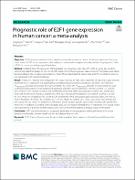| dc.identifier.citation | Li, J., Bi, W., Lu, F., Pan, B., Xiong, M., Lubanga, N., Nie, Z., & He, B.(2023). Prognostic role of E2F1 gene expression in human cancer: a meta-analysis. BMC cancer, 23(1), 509. | en_US |
| dc.description.abstract | E2F1 has been confirmed to be highly expressed in a variety of cancers. To better understand the prognostic value of E2F1 in cancer patients, this study was conducted to comprehensively evaluate the prognostic value of E2F1 in cancer according to published data. PubMed, Web of Science and CNKI database were searched until May 31st, 2022 using keywords to retrieve the published essays on the role of E2F1 expression in the prognostic value of cancer. The essays were identified according to the inclusion and exclusion criteria. The pooled result of the hazard ratio and 95% confidence interval was calculated with Stata17.0 software. A total of 17 articles were included in this study involved in 4481 cancer patients. The pooled results showed that higher E2F1 expression was significantly correlated with unfavorable overall survival (HR = 1.10, I2 = 95.3%, *PHeterogeneity = 0.000) and disease-free survival (HR = 1.41, I2 = 95.2%, *PHeterogeneity = 0.000) of cancer patients. Such a significant association of was maintained subgroup of sample size of patients (> 150: for OS, HR = 1.77, and for DFS, HR = 0.91; or < 150: for OS, HR = 1.93, and for DFS, HR = 4.39), ethnicity (Asian: for OS, HR = 1.65, and for DFS, HR = 1.08; or not Asian: HR = 3.55, and for DFS, HR = 2.87), the data from database (clinical: for OS, HR = 1.24, and for DFS, HR = 1.40; or database: for OS, HR = 2.29, and for DFS, HR = 3.09), paper published year (after 2014: for OS, HR = 1.90;and for DFS,HR = 1.87; or before 2014: for OS, HR = 1.40, and for DFS, HR = 1.22); cancer type (female specific cancer: for OS, HR = 1.41, and for DFS, HR = 0.64; or non-gender specific cancers: for OS, HR = 2.00, and for DFS, HR = 2.95). In addition, according to the database data, we also found that higher E2F1 expression level would lead to worse prognosis of patients, and the results were consistent with the statistical analysis results in the paper. | en_US |

